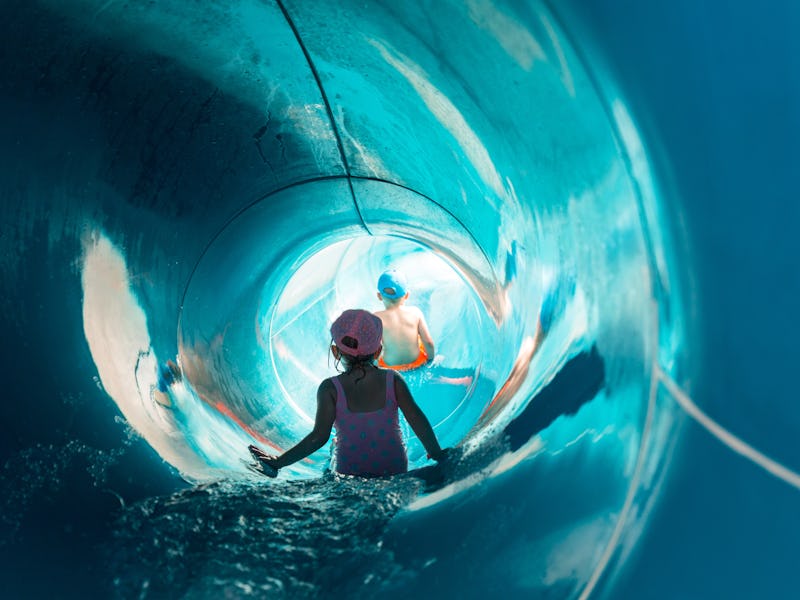Leaf-inspired material could solve a major drinking water problem
Scientists find inspiration in an unlikely place.

A scientific breakthrough can strike anywhere — when you’re lounging in the bath, out for a run, or even in your dreams. But for a new discovery made by Zuankai Wang and colleagues, inspiration came in a more unusual form: the decorative plants of an amusement park.
Wang, who is a professor of mechanical engineering at the City University of Hong Kong, tells Inverse that it was at Hong Kong’s Ocean Park that his postdoctoral fellow, Feng Shile, became fascinated by the unassuming Araucaria plant — a type of evergreen with stiff and densely packed needles or petals.
At Ocean Park Hong Kong you can enjoy food, amusement — and scientific breakthroughs.
Studying the leaf’s strange curvature, which is formed by tightly packed curved needles nested onto each other, the pair quickly realized there was something even more unusual lying within. Namely, an intrinsic ability to control the flow of fluids on its surface without exerting any external energy.
“I realized that this seemingly simple directional transport of fluid could raise a profound scientific question: can a fluid on the same surface choose its spreading direction without external energy input?” Wang says. “Keeping the curiosity in mind, we conducted a thorough and systematic investigation to unravel the puzzle.”
A kind of evergreen tree, Araucaria has a particularly dense and stiff petal structure that moves fluids in a peculiar way.
This form of real-life water bending, harnessing the characteristics of this plant could help scientists control the flow of water and other fluids like never before, which Wang tells Inverse could lead to breakthroughs in areas like desalination and electronic cooling.
Such innovation would be crucial in low-resource areas where power and clean water may be limited.
The findings were published Thursday in the journal Science.
What’s new — When water drips off leaves, Wang explains that it does so in a way that uses the least amount of energy. Usually, this means succumbing to the weight of gravity and letting water flow downwards. For the individual ratchets of the Araucaria plant, this isn’t always the case.
Instead, this plant uses the shape of its ratchets (the term Wang and colleagues use for the needles) to discriminate between different fluid types based on their surface tension and send them in different directions — either forward along the longitudinal curve or backward along its transverse underside.
“Preliminary studies identified that ethanol spreads along the ratchet-tilting direction whereas water propagates in the opposite direction,” says Wang.
If the Araucaria leaf was a microscopic waterpark ride, then the ratchets act as an automatic sensor to change to rides course accordingly for different passengers.
How they did it — Instead of collecting bunches of Araucaria for their work, the team took what they learned from the plant’s natural design and created a bioinspired surface to mimic it, fittingly called ALIS (Araucaria leaf-inspired surface.)
While the pallid and plastic-y appearance of ALIS doesn’t look very plantlike, the key similarity is the asymmetrical array of 3D ratchets on its surface like tiny hairbrush bristles. Through a number of experiments on different fluids, including water mixed with both ethanol and salt, Wang says the team demonstrated that this design effectively provided directional steering, self-propulsion, and high-velocity fluid flow.
Based on the surface tension of different fluids, such as plain water or ethanol, the team found that the fluids were transported differently.
“Our work demonstrates that the largely unexplored 3D capillary ratchet can be cleverly harnessed to impart many advantages,” Wang says. “The new strategy allows us to access uncharted territories in fluid control for exciting applications, like intelligent fluidic control, on-demand chemical reactions.”
What’s next — But while their experiments did show promise, Wang says none of these benefits are ready for their public debut quite yet. Desalination using this technology, for example, showed a positive effect but was not yet very efficient, Wang says.
For now, the team is focused on exploring the fundamentals of this technology and how it could be further improved in the future.
Abstract: Conventional understanding has it that a liquid deposited on a surface tends to move along directions that reduce surface energy, which is mainly dictated by surface properties rather than liquid properties, such as surface tension. Achieving well-controlled directional steering remains challenging because the liquid-solid interaction mainly occurs in the two-dimensional (2D) domain. We show that the spreading direction of liquids with different surface tensions can be tailored by designing 3D capillary ratchets that create an asymmetric and 3D spreading profile both in and out of the surface plane. Such directional steering is also accompanied by self-propulsion and high flow velocity, all of which are preferred in liquid transport.
This article was originally published on